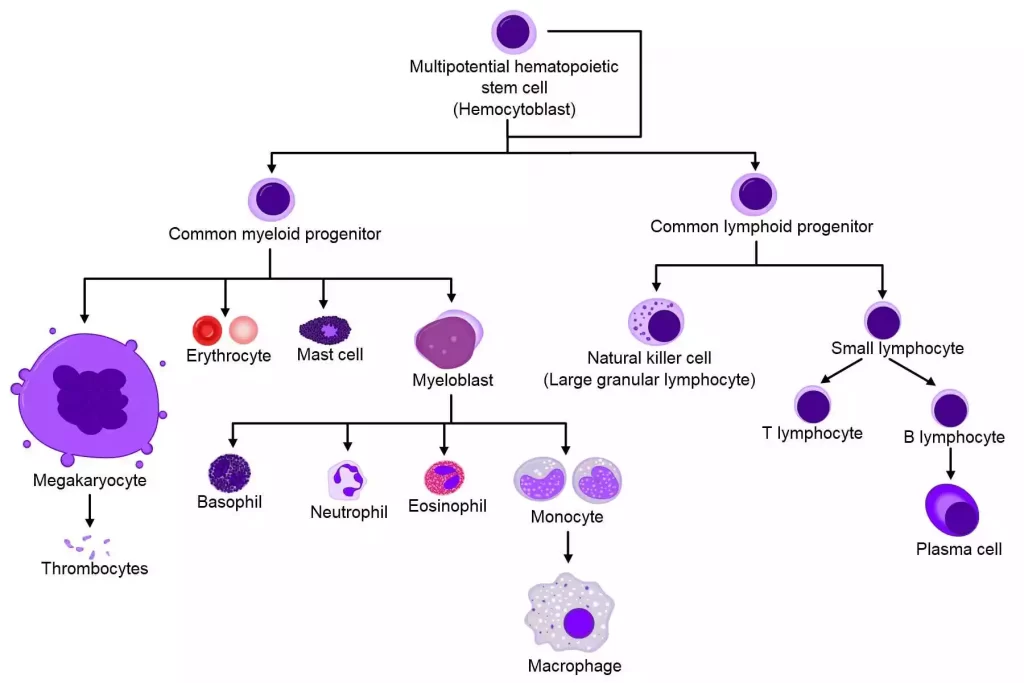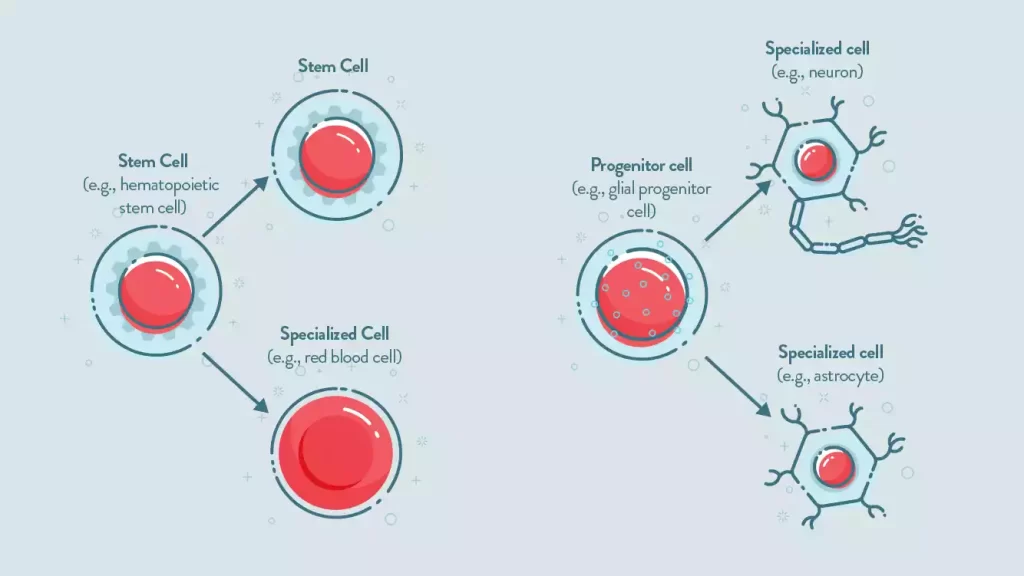The key difference between hematopoietic stem cells and progenitor cells is, Think of the hematopoietic stem cell as the ultimate multitasker. Hematopoietic stem cells have a unique superpower – they can transform into many different cell types. They are like giants, capable of turning into any blood cell in our body.
On the other hand, progenitor cells are like specialists. They are descendants of hematopoietic stem cells, and they have a specific function. They differentiate into very specific cells. It’s like having a team of experts, each with their own role.
Hematopoietic stem cells are the all-in-one package, while progenitor cells are like specialists who focus on their specific roles. Both are essential to our body’s function, and they work together to keep us healthy.
What are Hematopoietic Stem Cells?
Hematopoietic stem cells (HSCs) are a type of multipotent stem cell found primarily in the bone marrow and, to a lesser extent, in peripheral blood. These remarkable cells play a crucial role in the production and maintenance of the body’s blood and immune cell supply.
Key characteristics and functions of hematopoietic stem cells include:
- Versatility: HSCs have the remarkable ability to differentiate into a wide range of specialized blood cells. These include red blood cells (erythrocytes), white blood cells (leukocytes), and platelets (thrombocytes), all of which are vital for various functions in the body.
- Regeneration: Hematopoietic stem cells have the unique capacity to continuously self-renew and maintain a pool of stem cells for the lifelong production of blood cells. This regenerative ability ensures a constant supply of blood cells throughout an individual’s lifetime.
- Hematopoiesis: Hematopoiesis is the process of blood cell formation. Hematopoietic stem cells give rise to progenitor cells, which, in turn, differentiate into specific blood cell lineages.
- Bone Marrow Reservoir: The bone marrow serves as the primary residence for hematopoietic stem cells. Here, they reside in specialized niches where they remain quiescent until needed to replenish and repair the blood cell population.
- Medical and Therapeutic Significance: Hematopoietic stem cells are widely used in medical treatments, particularly in bone marrow transplantation for individuals with hematological disorders like leukemia or aplastic anemia. They can also be manipulated for regenerative medicine and gene therapy applications.

Hematopoietic stem cells are pivotal in maintaining the body’s blood cell supply, and their versatility makes them invaluable in both medical treatments and scientific research related to blood disorders and regenerative medicine.
What are Progenitor Cells?
Progenitor cells, also known as precursor cells, are a type of cell that falls somewhere between stem cells and fully differentiated, specialized cells in terms of their differentiation potential. These cells are committed to developing into a specific type of cell but still retain the capacity to proliferate and generate a limited range of related cell types.
Key characteristics and functions of progenitor cells include:
- Differentiation Path: Progenitor cells are more specialized than stem cells. They have already committed to a particular differentiation pathway, meaning they are destined to become a specific type of cell, such as a red blood cell, white blood cell, or platelet in the case of hematopoietic progenitor cells.
- Limited Proliferation: While progenitor cells can divide and replicate, their proliferation potential is more restricted compared to stem cells. They produce a defined number of specialized cells and do not have the same capacity for self-renewal as stem cells.
- Function in Tissue Regeneration: Progenitor cells play a crucial role in tissue repair and regeneration. When specific tissue or organ damage occurs, these cells can rapidly generate new cells of the desired type to facilitate the healing process.
- Localization: Progenitor cells are often located within specific tissues, close to where they will ultimately function. For example, hematopoietic progenitor cells are found in the bone marrow, as this is where blood cell production occurs.
- Therapeutic Applications: Progenitor cells are being explored for various therapeutic applications, including tissue engineering and regenerative medicine. They offer the potential to replace damaged or dysfunctional cells in specific tissues or organs.

Progenitor cells are partially specialized cells that serve as intermediaries between stem cells and fully differentiated cells. They are committed to a specific cell lineage but retain the ability to generate a limited range of related cell types, making them essential for tissue repair, regeneration, and potential medical interventions.
Between Hematopoietic Progenitor and Stem Cells Comparison chart
Hematopoietic progenitor cells and hematopoietic stem cells are both crucial elements in the development and maintenance of the blood and immune system. However, they are distinct in their capabilities and functions.
Below is a comparison chart to help differentiate between the two:
| Property | Hematopoietic Stem Cells | Hematopoietic Progenitor Cells |
|---|---|---|
| Self-renewal | Yes | No |
| Multipotency | Yes (can give rise to multiple cell types including all blood cells) | Limited (committed to specific lineages) |
| Lifespan | Long-term | Short-term |
| Differentiation Potential | High (can differentiate into all types of blood and immune cells) | Limited (can differentiate into fewer types) |
| Role in Transplantation | Can fully reconstitute the hematopoietic system | Can only replenish specific lineages temporarily |
| Location | Mainly in bone marrow but also found in peripheral blood and umbilical cord blood | Mainly in bone marrow but also can be mobilized to peripheral blood |
| Surface Markers | CD34+, often CD38- | Often CD34+ and CD38+ |
| Role in Homeostasis | Responsible for maintaining the lifelong production of blood cells | Involved in rapid response and specific lineage production |
| Niche Requirement | Requires specific microenvironment in bone marrow for self-renewal | Less stringent requirement for niche support |
| Regulation | Tightly regulated by various cytokines, chemokines, and cell-cell interactions | Often guided by more immediate cytokine signals for differentiation |
| Clinical Use | Used in hematopoietic stem cell transplantation to treat diseases like leukemia, lymphoma, etc. | More limited in clinical use but can be helpful in specific settings |
| Sensitivity to Therapies | Generally more resistant to chemotherapy due to a quiescent state | More sensitive to chemotherapy and radiation as they are often actively dividing |
| Numbers in Bone Marrow | Fewer in number | More abundant |
Note: This chart is a simplified comparison and may not encompass all details, as research in this area is ongoing.
Similarities of Hematopoietic Stem Cells and Progenitor Cells
Hematopoietic stem cells and progenitor cells share several similarities, despite their distinct roles in the process of blood cell production.
Here are the common features they have:
- Blood Cell Generation: Both hematopoietic stem cells and progenitor cells are involved in the production of blood cells. Hematopoietic stem cells are at the top of the hierarchy and give rise to progenitor cells, which then differentiate into specific blood cell types.
- Reside in Bone Marrow: Both types of cells are typically found within the bone marrow, creating a close physical association in the same environment. The bone marrow provides a supportive niche for their development and differentiation.
- Proliferation: Both hematopoietic stem cells and progenitor cells have the capacity to divide and proliferate. They can undergo multiple rounds of cell division to ensure an adequate supply of blood cells in the body.
- Regeneration: Hematopoietic stem cells and progenitor cells play essential roles in the regeneration of blood cells. In response to factors such as injury, infection, or changes in the body’s demands, these cells can increase their activity to produce more blood cells.
- Medical Significance: Both types of cells have significant medical and therapeutic relevance. Hematopoietic stem cells are used in bone marrow transplantation for the treatment of blood-related disorders, while progenitor cells are explored in various regenerative medicine and tissue engineering applications.
While they share these commonalities, it’s crucial to recognize their primary differences, especially in terms of differentiation potential. Hematopoietic stem cells possess pluripotency and can become various blood cell types, whereas progenitor cells are more lineage-committed and differentiate into specific, predetermined cell types within the blood cell family.
Importance in Health and Medicine
Hematopoietic stem cells and progenitor cells are of great importance in the fields of health and medicine due to their roles in blood cell production, tissue repair, and various medical applications:
Importance of Hematopoietic Stem Cells:
- Blood Cell Supply: Hematopoietic stem cells are essential for maintaining a continuous supply of various blood cell types, including red blood cells (erythrocytes), white blood cells (leukocytes), and platelets. This is crucial for the body’s overall health and function.
- Bone Marrow Transplantation: Hematopoietic stem cells are used in bone marrow transplantation procedures to treat individuals with blood-related disorders, such as leukemia, lymphoma, and aplastic anemia. These transplants can replace damaged or cancerous blood cells with healthy ones.
- Regenerative Medicine: Research into the therapeutic potential of hematopoietic stem cells is ongoing, with applications in regenerative medicine, particularly in the treatment of conditions that affect the blood and immune system.
- Gene Therapy: Hematopoietic stem cells are also investigated for gene therapy applications. By modifying these cells, scientists aim to correct genetic disorders, such as sickle cell disease and severe combined immunodeficiency (SCID).
Importance of Progenitor Cells:
- Tissue Repair: Progenitor cells play a critical role in tissue repair and regeneration. When damage occurs to specific tissues or organs, progenitor cells can differentiate into the required cell types to facilitate healing.
- Regenerative Medicine: Progenitor cells are explored for regenerative medicine applications beyond blood cell production. They hold the potential for the repair and replacement of damaged or degenerated tissues in various parts of the body.
- Tissue Engineering: In the field of tissue engineering, progenitor cells are employed to create bioengineered tissues and organs. These artificial tissues can be used for transplantation or as in vitro models for drug testing and research.
- Medical Research: Progenitor cells are crucial for advancing our understanding of development, tissue-specific differentiation, and disease mechanisms. Their study contributes to the development of novel treatments and therapies.
Both hematopoietic stem cells and progenitor cells are central to the development of therapies for a wide range of medical conditions. Their regenerative and differentiation capabilities have the potential to significantly impact the field of medicine, from blood-related disorders to tissue engineering and beyond.
The conclusion of the article
Hematopoietic Stem Cells (HSCs), and Progenitor Cells are both essential for the production and maintenance of blood cells. HSCs are multipotent cells that can self-renew and can differentiate into different types of blood cells. They are used in many clinical applications, including transplantation.
The progenitor cell, on the contrary, is a partially specialized cell with limited differentiation potential. They commit to specific lineages and produce a subset within that lineage. Progenitor cells contribute to subsets within a particular lineage. HSCs, on the other hand, are less specialized with a wider differentiation potential.
